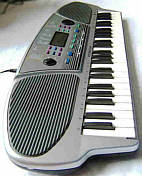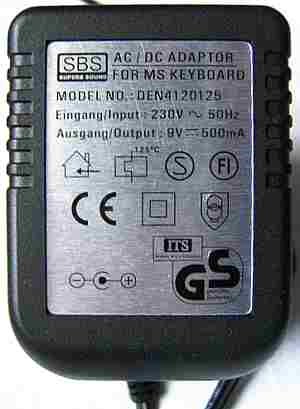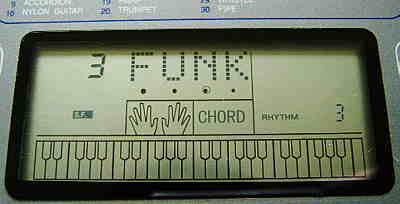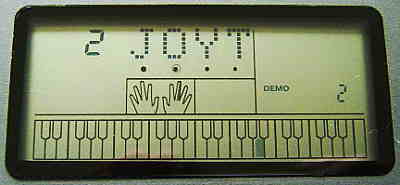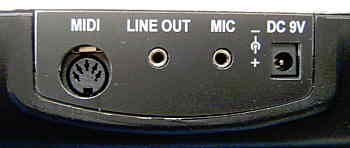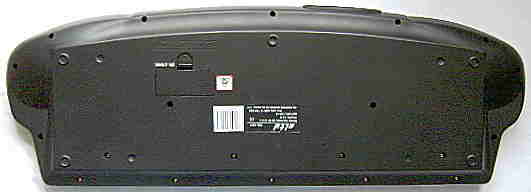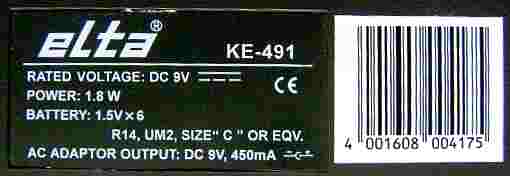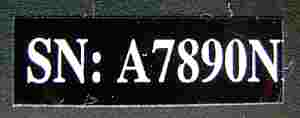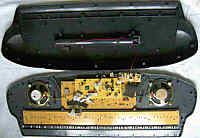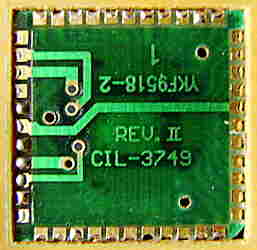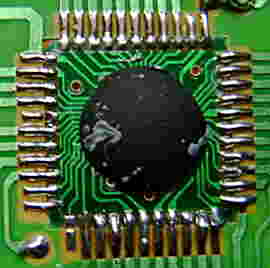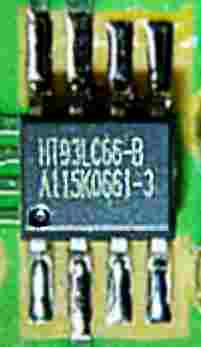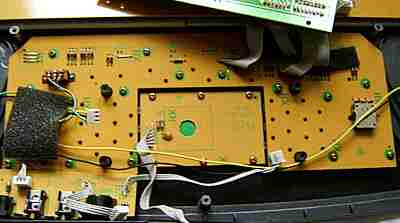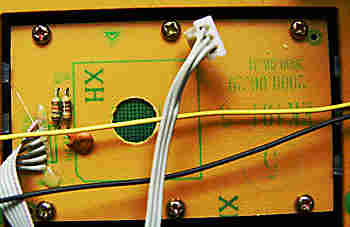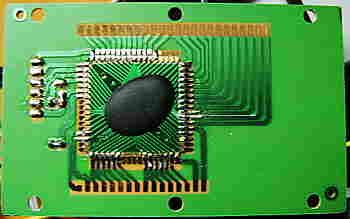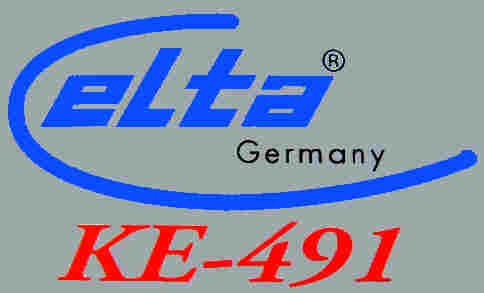 |
|
digital
lo-fi keyboard with simple synth, programmable rhythm, play teaching &
MIDI- out |
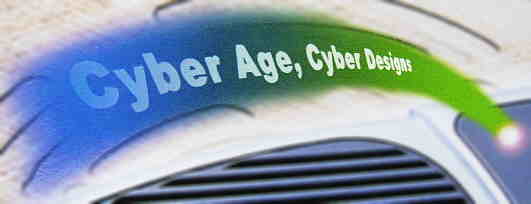 |
This stylish looking silver midsize tablehooter has MIDI- out, programmable
rhythm, play teaching through an LCD and even a simple synthesizer, but
the main voice is only a thin and glassy sounding My
Music Center variant with strong DAC aliasing distortion in high
notes.
The concept and flaws of this instrument remind much to the First
Austria MC-36 although both sound quite different. The rhythms,
accompaniment and many behaviour details have strong similarities with
the toy keyboard K-Mark WP9019A1 although
the latter had even a more sophisticated main voice. The only 4 note polyphonic
sound generator of the KE-491 seems to be a slightly improved My
Music Center variant those timbres contain much digital noise,
a dose of chorus and noticeable zipper noise. Despite the 30 preset sound
names even appear in the LCD as 4 letter abbreviations and the sound generator
tries very hard to find its best matching timbre (which is no matter of
course with such tablehooters), the result sounds thin, cold and noisy
and doesn't really satisfy the ear. Even for fans of the My Music Center
hardware
family it is IMO not the best sounding variant, because it yells too harsh
and thin and wannabe hifi, but at least it is the only known My Music Center
successor with a built-in synthesizer and has well responding keys, thus
it may become a kind of holy grail for some of you.
 The
simple synth mixes any 2 of the 30 preset sound waveforms and sends the
result through a volume envelope. Unfortunately there are only 6 boring
preset envelopes of natural instruments available, the 2 subvoices can
not be set to different envelopes and also the volume ratio of both oscillators
can not be changed, which makes the result always sound very establishment.
It can e.g. create nicely sonorous pipe- and reed organ timbres, but it
has nothing to do with the dinosaur, whistle or motorcycle sound icons
those advertise the synth feature on the box. At least there is an effect
button to add either vibrato, echo or detuned chorus to any main voice
sound. The digital ice- age appeal of the sounds partly reminds to the
Hohner
KS 49 midi synth, although the latter is much more versatile and
based on different technology. The
simple synth mixes any 2 of the 30 preset sound waveforms and sends the
result through a volume envelope. Unfortunately there are only 6 boring
preset envelopes of natural instruments available, the 2 subvoices can
not be set to different envelopes and also the volume ratio of both oscillators
can not be changed, which makes the result always sound very establishment.
It can e.g. create nicely sonorous pipe- and reed organ timbres, but it
has nothing to do with the dinosaur, whistle or motorcycle sound icons
those advertise the synth feature on the box. At least there is an effect
button to add either vibrato, echo or detuned chorus to any main voice
sound. The digital ice- age appeal of the sounds partly reminds to the
Hohner
KS 49 midi synth, although the latter is much more versatile and
based on different technology. |
But also the digitalistic operating concept of the KE-491 is awkward
and not remotely OBS; despite there are no menues, all sounds and rhythms
are selected through a dial (named 'twirling wheel' in the Engrish manual)
and have to be confirmed with a beeping 'enter' button, and you can not
even select a different preset sound without stopping the rhythm. Also
the 5 memory settings for user programmed synth sounds and 6 for rhythms
don't help here. The percussion is made from medium resolution samples
and the 10 rhythms play too loud in ratio to their accompaniment. Despite
there is a fingered chord mode, it accepts only establishment chords, turns
the main voice monophonic and there is no manual chord mode at all. Most
of the 10 accompaniments sound like reggae. The right keyboard section
can be switched into keyboard drumkit mode. Also the play training feature
is very questionable, because the 10 demo songs used by it contain so many
own flaws that it is hard to understand how anybody should learn correct
keyboard play from them. But at least the accompaniment loops from the
one key play mode can be abused for tekkno.
This instrument was also released as Top-Toy A/S - Keyboard 400
(panel and speakers black).
main features:
-
49 midsize keys
-
2 built-in 10cm speakers (stereo, sound thin and bassless with unpleasant
midrange resonance)
-
main voice polyphony 4 notes (only 3 with rhythm, 1 with accompaniment)
-
30 preset sounds {piano, electric piano, harpsichord, celeste, organ, bell,
music box 1..2, accordion, nylon guitar, electric guitar, jazz guitar,
banjo, e. bass, violin, cello, string 1..2, harp, trumpet, tuba, french
horn, brass, synthetic brass, flute, oboe, clarinet, alto saxophone, whistle,
pipe} (selected through dial + 'enter' button)
-
10 preset rhythms {disco, dance, funk, ballad, fussion, pop bossa, cha
- cha, slow waltz, march, polka)
-
additionally 5 user preset sounds & 6 user preset rhythms (selected
like normal ones)
-
dial to select sounds, rhythms, demo songs
-
volume +/- buttons (16 steps)
-
tempo +/- buttons (32 steps)
-
transpose +/- buttons (13 semitone steps (-6..+6))
-
single finger & fingered chord accompaniment (only standard chords,
no manual chord mode)
-
effect button {vibrato, echo, 'reverb' = detuned chorus}
-
keyboard drumkit mode {base, snare, close hihat, cymbal, tom, cowbell,
hand clap, shaker}
-
rhythm fill-in button
-
primitive sequencer (monophonic record/ play of 40 notes, no edit, sequence
is deleted when other functions are used)
-
programmable rhythm (monophonic, 5 user patterns)
-
simple synthesizer (2 preset waveforms + 1 volume envelope, 5 user sounds)
-
LCD display (shows tempo, selected sound/ rhythm/ song, keyboard keys &
finger placement, synth parameters etc.)
-
sound generator resembles My Music Center.
It has only very simple volume envelopes (attack- decay?) with noticeable
zipper noise. High notes have unpleasant aliasing noise by too low DAC
output frequency. Percussion is made from unlooped medium resolution samples
(with audible end click).
-
multi- chip hardware:
-
CPU= "CIL-3749, REV. II, YKF9518-2, 1" (44 pin COB)
-
LCD controller= "CIL-3749/HT-, YKF965, A, 1" (68 pin COB)
-
EEPROM= "HT93LC66-B, ALI5K0661-3" (8 pin SMD, 512 byte, The instrument
holds user data without battery. The manual mentions "MEMORIES: 4 Kbit".)
-
learning feature & one key play (displays keys & finger position
of right hand on the LCD)
-
10 demos (also used for learning feature)
-
auto- power off (resets everything after a key press)
-
jacks for AC- adapter, microphone, line out, MIDI- out
eastereggs:
-
When a user sound is selected and the instrument is switched into MIDI
mode, then the 2nd subvoice of played notes will be muted semi- randomly
at about every 2nd pressed key. The phenomenon does not occur so long the
vibrato or echo effect is enabled.
notes:
The electronics of this instrument looks astonishingly well constructed;
the ribbon cables have plug connectors and there is no cable mess at all,
which is quite unusual for such a poor sounding tablehooter. The case shape
and PCB design strongly resemble the Superb
Sound EK-905, while the horizontal lines and groves in the silver
case also remind to the stylish Sankai
01870K. Also the preset sound names are correct; only some keyboard
drumkit icons are slightly wrong. During rhythm there is a horizontal walking
light of 1 red and 3 green LEDs, which reminds to the small K-Mark
WP9019A1 that has many rhythms and behaviour details common with
it. Annoying is that the auto- power off resets the entire instrument with
a buzzy beep; after a key press it comes up with a cold start at quite
high volume. All buttons play a blip sound that disturbs live performance,
and the stubborn user interface also has various other severe flaws those
remind to Yamaha PSS-31. E.g. you
can not select another preset sound without stopping the rhythm; any rhythms,
sounds and demo songs are selected with a dial (showing the abbreviated
name in the LCD) and confirmed with the 'enter' button ("beep!"...). But
to switch the dial among {voice, song, rhythm, MIDI} mode you have to turn
a rotary switch that always stops running rhythm, and because you can only
start a rhythm in 'rhythm' mode, there is no chance to use it so long you
are in 'voice' (i.e. preset sound select) mode. The sound of the Elta KE-491
is unpleasantly thin, noisy and cold, but I am not sure if this is only
an analogue flaw by a poorly designed (oscillating) power amplifier; it
also distorts a bit and at higher volume and there is always fairly loud
static noise in the background. Perhaps the flaw can be fixed, which would
turn the KE-491 into a nicely versatile lo-fi instrument.
Astonishing is that the instrument even holds user programmed sound,
rhythm and sequencer data without battery; the manual mentions "MEMORIES:
4 Kbit". On the PCB I indeed found a Holtek(?) 512 Byte serial EEPROM.
(Although the low capacity doesn't suggest it, I can only hope that the
internal ROM software is not also stored this way, because flash ICs are
infamous to loose their data after only 1 or 2 decades and can easily become
corrupted by a program crash. Thus be very careful with circuit bending
attempts on this instrument.) Strange is also that the manual claims polyphony
to be 8 channels, while in reality it has only 4; either they referred
to the internal count of subvoices (each main voice sound employs 2 subvoices
for chorus), or there is an easteregg hidden somewhere to disable the chorus
effect in favour for twice the polyphony. (I haven't analyzed the hardware
closer yet.)
The preset sounds are made from each a static waveform with simple volume
envelope and a dose of chorus. Despite the sound generator seems to be
very similar to My Music Center
(see there), the timbres and envelope durations here have been chosen with
much more care than in most other My Music Center variants, which
within the narrow hardware limits makes the preset sounds here indeed sound
like what their names suggest. All sounds employ a 2nd suboscillator for
chorus, which is here detuned very little; like with Feng
Yuan 28061 the chorus tremolo speed increases with higher notes.
Because most presets sound like expected, I only explain the unusual ones
here. Likely there are also some additional waveforms in comparison to
the old My Music Center, since e.g. the "pipe" sound is a sonorous
metal pipe organ rank timbre, which also exists on the greatly versatile
Potex
- Super Jam. "organ" decays a little after its slow attack and
thus resembles a cello. "music box 1" has a 2s long sustain, while "2"
is rather a slowly decaying bowed glass. "e. guitar" is more an e-piano,
"jazz guitar" a banjo. "string 2" could be also a warm and sonorous reed
organ. "tuba" turns harsh in high notes but sounds ok in the bass range.
"synthetic brass" sounds a bit like a small plastic reed organ. "whistle"
has strong chorus and sustain and reminds rather to a bowed glass or vox
humana organ rank.
The 'effect' button adds one of 3 effects to the main voice sound; "Vib."
adds a square 7Hz vibrato, "Echo" chops and retriggers the note with about
2.5Hz and falling volume, which produces a kind of 4 second long echo.
Quite unique is that short notes are not affected; the echoing starts only
when the note sounds long enough to make it re-trigger the first time,
which can either be caused by long internal sustain of the selected sound
or by holding the key long enough. "Rev." is no reverb, but genuinely only
a stronger detuned (but still harmonious) version of the normal chorus.
The synthesizer is easy to use but not remotely as versatile as e.g.
a Casio VL-Tone 1. To use it, turn
the mode knob to 'voice' and press 'program'. Select with the dial one
of 6 volume envelopes {piano, music box, guitar, violin, saxophone, banjo}
and press 'enter'. Select with the dial the first waveform from the 30
preset sounds and press enter. Repeat the same for the 2nd waveform (both
are mixed to create the timbre, use both the same when you want only one
waveform). You can test the sound on the keyboard. Press 'program' again
to save the sound. But instead of letting the user decide which sound he
wants to overwrite, the instrument apparently stubbornly saves in ascending
order to the sound numbers from 31 to 35 (named 'CUS1'..'CUS5') and overwrites
the first one again when more than 5 user sounds are saved. (It's a good
idea to write down the selected envelope and waveform numbers during sound
programming.) Unfortunately there is is no MIDI- in jack to be used with
the synth. A bizarre bug is that when a user sound is selected and the
instrument is switched into MIDI mode, then the 2nd subvoice of played
notes is muted semi- randomly at about every 2nd pressed key. The phenomenon
does not occur with enabled vibrato or echo effect. The 6 volume envelopes
are nothing remotely spectacular. "piano" and "guitar" are what their names
suggests. "music box" is percussive and decays with 2 seconds long sustain
(3 with held notes). "violin" is a continuous tone with non- percussive
attack and short sustain; "saxophone" is the same with more percussive
attack. "banjo" is almost identical with "guitar" and only decays a tiny
little slower (which is mostly audible in the timbre of the zipper noise
of high notes).
In MIDI mode neither rhythm nor any other fancy functions can be used.
Bizarre is that the preset sound is now stepped up and down with the 'learn'
and 'one key' buttons. Also the 'percu' button (drumkit mode) and the 'effect'
button still work. (I haven't tested MIDI yet.)
The 10 accompaniments and the medium resolution percussion samples strongly
resemble K-Mark WP9019A1. Many rhythms
hammer like a wild staccato with an overdose of shaker noise. Unfortunately
there are no separate volume controls for rhythm and accompaniment. The
accompaniment patterns are over- orchestrated and thus less versatile;
most remind to reggae, and with accompaniment the main voice turns monophonic.
The accompaniment continues during rhythm fill-in. A nasty bug is that
the transpose +/- buttons do not transpose also the accompaniments, which
makes them almost useless. The same bug also exists in the WP9019A1,
with the difference that there the buttons do nothing so long the accompaniment
is running, and that I had added them only as an easteregg. The 'percu'
button switches the white keys of the right keyboard section into drumkit
mode. The cymbals even sounds nicely metallic, although the samples are
thin and stop with a sudden end click. A little strange is that the sharps
(black keys) between the white drumpad keys here still play their normal
notes. The drumpad keys also show wrong icons: {snare, tom H, cymbal R1,
cymbal S, base M, cowbell, hand clap, shaker, pause} instead of {base,
snare, close hihat, cymbal, tom, cowbell, hand clap, shaker, pause}.

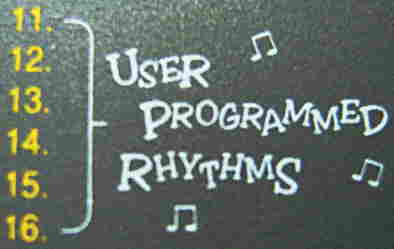 To
program a rhythm turn the mode knob to 'rhythm' and press 'program'. Enter
the (monophonic) rhythm step by step with the keyboard drumkit keys; use
the rightmost key to enter pauses. The rhythm has to be at least 16 steps
long. Press 'replay' to hear it and press 'program' again to save it. Like
with the synthesizer sounds, the instrument stubbornly saves in ascending
order to the rhythm numbers from 11 to 16 (named 'CUS1'..'CUS6') and overwrites
the first one again when more than 6 user patterns are saved. User patterns
can neither be combined with accompaniment nor use a fill-in. To
program a rhythm turn the mode knob to 'rhythm' and press 'program'. Enter
the (monophonic) rhythm step by step with the keyboard drumkit keys; use
the rightmost key to enter pauses. The rhythm has to be at least 16 steps
long. Press 'replay' to hear it and press 'program' again to save it. Like
with the synthesizer sounds, the instrument stubbornly saves in ascending
order to the rhythm numbers from 11 to 16 (named 'CUS1'..'CUS6') and overwrites
the first one again when more than 6 user patterns are saved. User patterns
can neither be combined with accompaniment nor use a fill-in. |
The primitive record/ playback sequencer is fairly useless but at least
it can keep its data in memory. To use it, turn the mode knob to 'song'.
Press 'program', play a monophonic melody to be recorded and press 'replay'
to hear it. Press 'program' again to save it to 'CUS1' (song number 11)
into memory. To play the saved song later, select song 11 again and press
'enter'. Selecting other numbers plays the demo melodies.
The 10 demo melodies of this instruments are:
-
Silent Night
-
Joy to the World
-
Susanna
-
It is a Little World [named "It is a Little Word" on Sankai
01504H]
-
London Bridge
-
Yankee Doodle
-
Auld Lang Syne
-
The Rhythm of Rain
-
Sailing
-
Surprise Symphony
These 10 songs are also used for the play teaching mode, despite their
complex polyphonic arrangements contain so many play faults (or were these
considered jazzy improvisations???) that it is questionable how anybody
should learn correct playing from them. Some of the demos strongly resemble
those on Sankai 01504H, with the
difference that the latter plays them with less flaws. Press 'learn' to
start the teaching mode, which works similar like key lighting. The LCD
indicates which key you should press while the accompaniment of the song
repeats in a loop until the correct key is hit; even the correct finger
is shown. Unfortunately it does not show at all the correct play timing
but lights up the next key as soon the previous one was hit, and the notes
to be played are always only monophonic. Another training mode is 'one
key', which behaves similar except that any key presses here step through
the melody. Both modes can also use the user song '11' in the sequencer,
although the latter neither has rhythm nor accompaniment to learn the correct
timing from. Like with My Song Maker,
also here the special accompaniment loop of the one key play mode can be
abused for tekkno. It's a pity that the programmer has not made them available
as additional standard rhythms and accompaniments. You can also transpose
the main voice in both modes, which will not transpose the special accompaniments
and thus sound even more cacophonic than the normal arrangements.
Likely a predecessor of the KE-491 was the Superb
Sound EK-905 (neither synth nor MIDI, based on FM sound). Another
high fidelity My Music Center successor was the fullsize
Yongmei
YM-2100.
| removal
of these screws voids warranty... |
|
|
 |

|
|
| |
back
|
|





